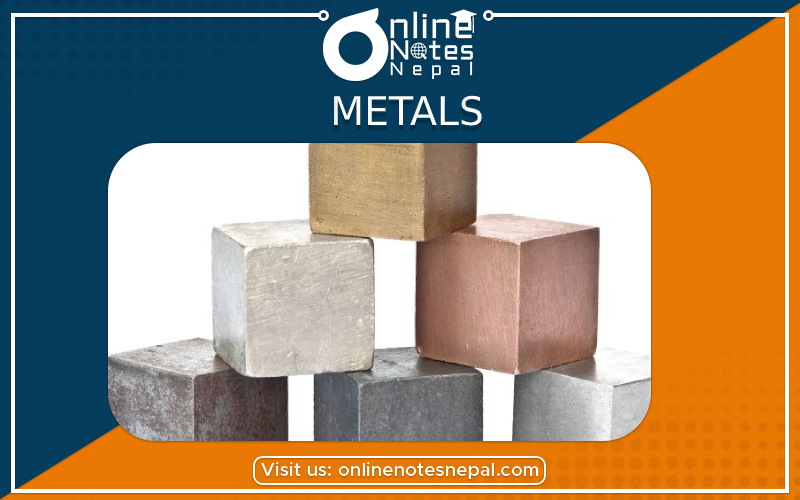Metal
Metal
There are total 118 elements found till today. Out of them, 92 elements are naturally found and 26 elements are artificially discovered. They have their own properties. Depending upon their properties, they are classified as metals, non- metals and metalloids. Among them, metals are widely used.
Those elements which have positive electric charge typically with a shiny surface and a good conductor of heat and electricity are known as metals. Metals are malleable and ductile. Generally, metals have high boiling points. Metals lie on D-Block of the periodic table.
Gold
Gold is a soft, lustrous yellow metal. It is a 'D' block transition element in the periodic table. It belongs to the period 6 and group IB. Some important ores of gold are:
- Calaverite
- Sylvanite
- Nagyagite
- Petzite
- Krennerite
Physical properties of gold:
- Gold possesses a lustrous yellow color.
- It has a melting point 1063°C and boiling point of 2610°C
- It is a heavy metal with specific gravity 19.3.
- It is a good conductor of heat and electricity.
- It is less reactive metal.
Uses of gold:
- It is used for making jewelry, coins, and medals.
- It is used for making gold leaf electroscope.
- It is used for making alloys.
Silver
Silver is the "D" block transition element. It belongs to the group IB of the periodic table. Some important ores of silver are:
- Argentite
- Horn silver
- Silver copper glance
- Pyrolite
Physical properties of silver
- Silver is white lustrous metal.
- Its specific gravity is 10.52.
- Its melting point is 9600C and boiling point is 19550C.
- It is a good conductor of heat and electricity.
- It is malleable and ductile in nature.
Uses of silver
- It is used to make coins, jewelry, and decorative articles.
- Silver bromide is used in photography. It is used in electroplating.
Copper
Copper belongs to Group IB and period 4 of the periodic table. It is and' block element. It is also known as a transition element. Important ores of copper are:
- Cuprite (Ruby copper)
- Copper pyrite ( Chalcopyrite)
- Copper glance ( Chalcocite)
- Malachite
Physical properties of copper
- Copper is a red brownish metal with a metallic luster.
- It is a good conductor of heat and electricity.
- Its specific gravity is 8.95.
- It is highly malleable and ductile in nature.
- Its melting point is 1083°C and its boiling point is 2350°C.
Uses of copper
- Copper is used for making electrical goods and cables.
- It is used for making copper leaf electroscope.
- It is used for making utensils, coins, jewelry, etc.
- It is used in the manufacture of dyes and pesticides.
Iron
Iron is a transitional element and known as "d" block element. It belongs to Group VIII of the periodic table. It is the first transition series in the fourth period. On the left side of it, manganese is located whereas on the right-hand side, cobalt is found.
Important ores of iron are:
- Hematite
- Magnetite
- Siderite
- Limonite
- Iron pyrite
Physical properties of Iron
- Pure iron is a silvery white metal and lustrous metal.
- Its specific gravity is 7.86.
- Iron melts at 1550ºC and boils at 2400ºC.
- Iron is a good conductor of heat and electricity.
- It is malleable and ductile in nature.
Uses of Iron:
- It is used in the manufacture of steel.
- It is used in making household utensils.
- It is used as a catalyst in different chemical reactions.
- It is used in making rods, pipes, chains, vehicles, railway tracks, etc.
Aluminium
Aluminum is a 'p' block element. It belongs to the period 3 and group III A of the periodic table. Some important ores of aluminum are:
- Bauxite
- Feldspar
- China clay
- Caryolite
Physical properties of aluminium
- Aluminum is a bluish-white shining metal.
- It is the lightest metal and its specific gravity is 2.7.
- Its melting point is 6600C and boiling point is 18000C.
- It is a good conductor of heat and electricity.
- It is malleable and ductile in nature.
Uses of aluminum
- Aluminium is used for making utensils, frames, electrical appliances, etc.
- It is used for making electrical wire.
- It is used for making alloys and coins.
- Its alloys are used for making sailboats, aircraft, etc.
- It is used for making aluminum foils which are used for wrapping food, cigarette, etc.
